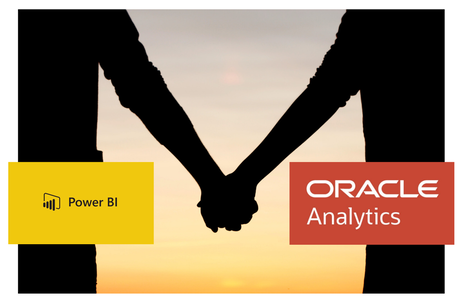|
Oracle Analytics Cloud (OAC) and Microsoft Power BI are two of the most popular platforms organisations use for data visualisation, reporting, and business analytics. It is common for companies today to have a "hybrid analytics ecosystem" meaning they utilise both OAC and Power BI, rather than standardising on just one. There are several reasons a hybrid approach may emerge: Oracle Analytics and Microsoft Power BI are 2 popular choices for businesses around the world for their Analytics solutions. In many cases, there is what I'll refer to as a "hybrid analytics ecosystem". Hybrid Analytics Ecosystem Many organisations today have a "hybrid analytics ecosystem" - meaning they use both Power BI and Oracle Analytics Cloud (OAC) or any other combination of analytics platforms for different analytics and reporting needs. There are several reasons this hybrid approach may emerge:
Whatever the reason, it's common for organisations to have a footprint in both Power BI and OAC (or any other combination of analytics platforms). This used to be seen as a challenge - "which one do we standardise on?" But modern integration and alignment features allow both platforms to coexist and complement each other rather than compete. This provides flexibility to leverage the strengths of both tools. The goal of this post is to show how Power BI and OAC can work together effectively in a hybrid analytics model to deliver insights across the business. Benefits of each platform An important benefit of Power BI is its tight integration with Microsoft 365 and components like Excel. Users are already familiar with Excel for ad hoc analysis, and Power BI makes it easy to share those same models and data to the entire organisation via dashboards and apps. The Microsoft stack alignment enables a seamless flow between data, analysis, and organisational sharing. For organisations invested heavily in Microsoft technology, Power BI is a natural fit to extend that analytics foundation. A key strength of Oracle Analytics Cloud is its semantic model that abstracts the complexity of the underlying data and technology stack from end users. Business analysts can access and analyse data without needing to understand the physical tables and relationships. OAC also enables strong data governance with centralised security rules, data logic definitions, and stewardship processes applied consistently across the semantic models. This top-down approach ensures quality and trust in the data while still empowering decentralised analytics. How They Can Work Together There is Power BI supported connectivity to Oracle Analytics that gives Power BI users access to Oracle Analytics content. Oracle Analytics provides an easily configured connector that enables Power BI Desktop access to the Oracle Analytics semantic model. More details on how to set it up can be found here. It should be noted that there are a number of limitations:
Conclusion Power BI and Oracle Analytics Cloud both offer compelling capabilities for data visualisation, reporting and analytics. Rather than viewing them as competing tools, organisations should consider how they can work together in a hybrid analytics environment. The key is to play to the strengths of each platform:
By taking a hybrid approach, both business users and data experts can win with the analytics capabilities they need. Rather than analytics chaos, a "best of both worlds" environment can emerge. Organisations can optimise their analytics investments and empower people with the right insights at the right time.
0 Comments
Your comment will be posted after it is approved.
Leave a Reply. |
AuthorA bit about me. I am an Oracle ACE Pro, Oracle Cloud Infrastructure 2023 Enterprise Analytics Professional, Oracle Cloud Fusion Analytics Warehouse 2023 Certified Implementation Professional, Oracle Cloud Platform Enterprise Analytics 2022 Certified Professional, Oracle Cloud Platform Enterprise Analytics 2019 Certified Associate and a certified OBIEE 11g implementation specialist. Archives
May 2024
Categories |


 RSS Feed
RSS Feed

